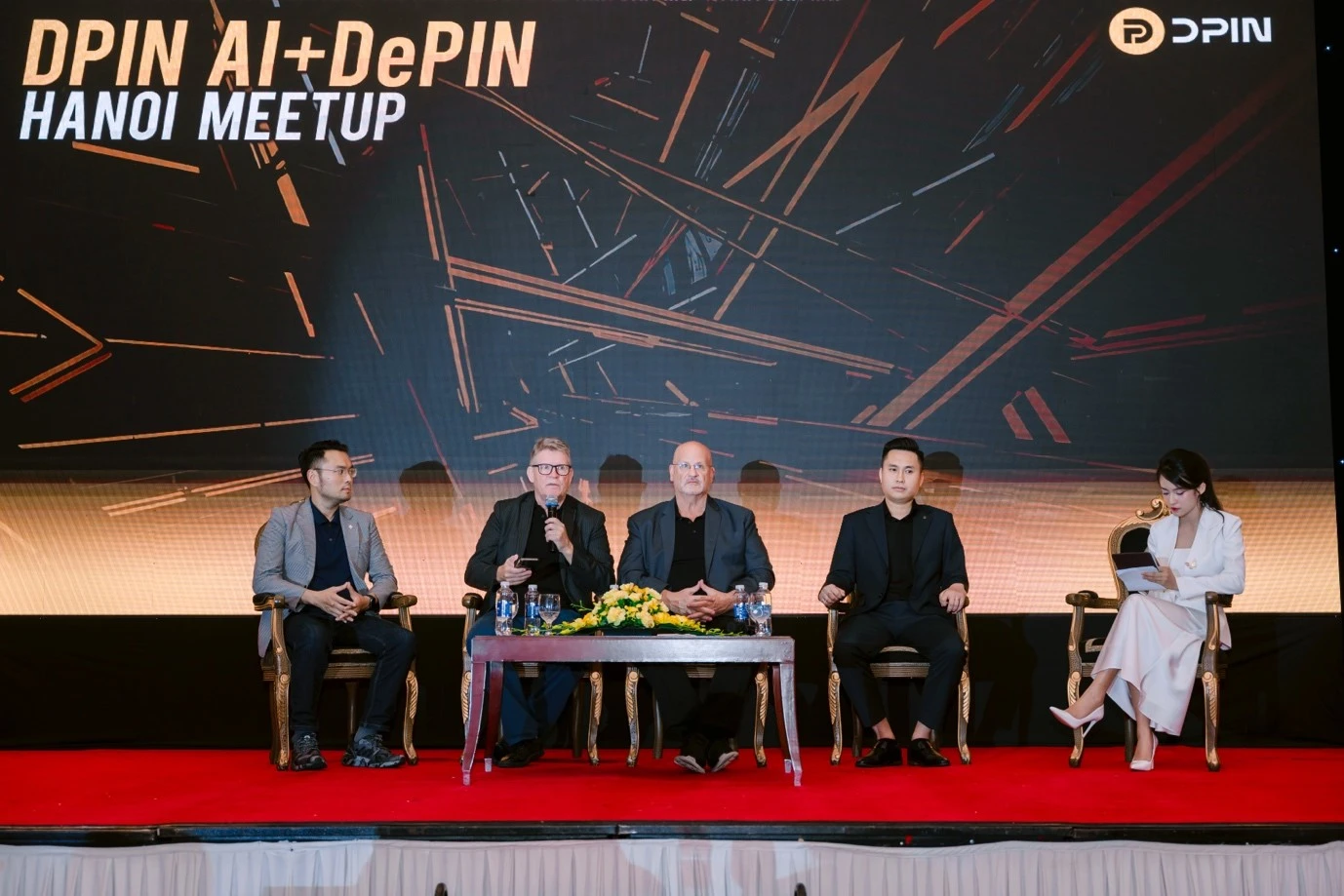
DePIN and RWA: Evolving Forces of Infrastructure and Asset Paradigms
At the beginning of the summit, Daniel Schwartz, the operating president of the DPIN Foundation, delivered an opening speech, systematically expounding on the core concept of DePIN. He pointed out that DePIN aims to build and maintain a physical infrastructure network owned and operated by the community by leveraging blockchain technology and token incentive mechanisms, thereby effectively avoiding the risk of single point failures in the traditional centralized model, significantly improving operational transparency, and giving back network value more fairly to community members who participate in the contribution. Daniel cited projects such as Helium (a decentralized wireless network), Filecoin (a decentralized storage network), and Energy Web (a decentralized network focusing on renewable energy) that have made significant progress as examples, vividly demonstrating the practical application potential and feasibility of DePIN in different fields.
Next, Daniel turned his attention to the tokenization of real-world assets (RWA). He explained that converting tangible or intangible assets such as real estate, precious metals (such as gold), artworks, and even carbon credits into digital tokens through blockchain technology is expected to break many barriers in the traditional asset market. RWA tokenization can greatly improve the liquidity of assets, making it possible to trade assets that were previously difficult to divide or trade in fragments; at the same time, based on the immutable and transparent characteristics of blockchain, the ownership records and transaction history of assets can be publicly verified, enhancing the trust of the market; in addition, it can also lower the investment threshold, allowing a wider range of investors to have the opportunity to access and invest in high-value assets.
When discussing the intrinsic connection between DePIN and RWA, Daniel emphasized the potential synergy between the two. He explained that the DePIN network can provide the necessary infrastructure support for the tokenization and management of RWA, for example, verifying the physical state or environmental data of assets through a decentralized sensor network, or using decentralized storage to ensure the security of relevant legal documents and ownership records. In turn, the successful tokenization of RWA and the economic activities it generates may also attract more participants and potential financial support for the development of the DePIN network, forming a mutually reinforcing virtuous circle.
Furthermore, when discussing the specific vision and long-term impact of the DPIN project, Daniel emphasized how the decentralized GPU computing network that DPIN is committed to building will bring positive changes to the global AI ecosystem. He pointed out that the goals of DPIN are:
Universal access to computing resources: By lowering the threshold for high-performance computing, more developers, researchers, and small and medium-sized enterprises can afford and use powerful GPU computing power for AI model training and reasoning.
Improve cost-effectiveness: Compared with traditional centralized cloud service providers, DPIN aims to provide users with more competitive prices by optimizing resource scheduling and utilizing distributed idle computing power.
Enhanced data security and privacy protection: Decentralized architectures naturally have stronger anti-censorship and data sovereignty characteristics. DPIN is committed to building a more secure data processing environment on this basis.
Provide dynamic scalability: Faced with the growing and volatile computing power requirements of AI models, DPIN’s distributed network is expected to provide more flexible and resilient computing power expansion capabilities to meet the needs of future AI development.
The intersection of exponentially growing AI computing power demands and decentralized solutions
Following closely, Pekka Kelkka, President of DPIN Computing Strategy and Chief Business Officer of QPIN, delivered a keynote speech, deeply analyzing the explosive growth trend of computing power demand in the current AI field. He cited data to point out that the demand for AI computing power is growing exponentially, and its iteration speed has far exceeded the traditional hardware performance improvement trajectory described by Moores Law. Pekka emphasized that the training of large language models (such as DeepSeek and other models dedicated to general artificial intelligence exploration), the massive data processing and real-time decision-making required for autonomous driving technology, and cutting-edge applications such as building immersive metaverse experiences are key factors driving this surge in demand.
Faced with such a huge computing power gap, Pekka pointed out that the key to meeting these needs lies in innovative solutions, and QPINs technology is the core driving force of the DPIN plan. He elaborated on the vital role played by QPIN in commercialization and core technology provision, emphasizing that QPIN is committed to building a global and efficient decentralized GPU computing platform. This platform is not only the foundation for DPIN to build its global GPU network, but also the key engine to promote the efficient operation of AI applications (such as complex models such as DeepSeek) in a decentralized environment. By leveraging the QPIN platform, DPIN aims to significantly reduce the hardware investment and operating costs required for AI research and development, significantly accelerate the training cycle of AI models through optimized large-scale data processing capabilities and low-latency computing characteristics, and ultimately achieve global, distributed and efficient use of computing resources. Pekka made it clear that the grand blueprint of the DPIN Foundation is highly dependent on the technical strength and continuous innovation of the QPIN platform to jointly build a decentralized GPU network that enables high-performance computing technology to benefit developers and users around the world.
Roundtable Insights: Opportunities, Challenges and the Future of Southeast Asia
The roundtable discussion at the summit brought together multiple perspectives and conducted in-depth discussions on the development prospects of DePIN, RWA and AI in Southeast Asia:
· Daniel Schwartz further elaborated on the potential advantages of DePIN over traditional data centers in AI application scenarios. He mentioned that through sophisticated distributed architecture design and intelligent task scheduling algorithms, the DePIN network is expected to achieve higher energy efficiency and reduce the carbon footprint of the computing process. At the same time, by effectively integrating and utilizing existing and potentially idle hardware resources around the world and reducing the construction and maintenance costs of large-scale centralized infrastructure, DePIN is committed to achieving significant cost-effectiveness. Looking to the future, Daniel reiterated DPINs long-term goals: to promote the popularization of AI applications, reduce the cost of innovation, improve the security and privacy protection of data processing, provide elastic and scalable computing power to meet future needs, and ultimately inspire a wave of technological innovation around the world.
·Ted Nguyen, a senior consultant in the field of RWA and NFT, shared his deep insights into the Vietnamese and broader Southeast Asian markets. He candidly pointed out the challenges faced by the region in developing DePIN and RWA, such as the lack of digital infrastructure in some regions and how to effectively respond to and adapt to the changing regulatory environment in the face of rapidly developing technologies. However, Ted emphasized the huge opportunities in the region: the rapid advancement of digital transformation provides a broad application scenario for new technologies; the growing local technical talent pool provides intellectual support for innovation; the relatively low operating costs have attracted global attention; the active start-up ecosystem is full of vitality; and the society and government levels generally hold an open and embracing attitude towards emerging technologies such as blockchain. These factors together constitute favorable conditions for Southeast Asia to become a hotbed for the development of DePIN and RWA.
·Pekka Kelkka detailed DPINs localized cooperation strategy in Vietnam and surrounding areas. He revealed that DPIN plans to establish joint research projects with top local universities to jointly explore cutting-edge technologies in DePIN and AI; actively support local potential start-ups by providing resources, computing power support and technical guidance; and deploy edge computing nodes in selected science and technology parks to create real application test environments (Living Labs) to verify and optimize technical solutions in actual scenarios. In addition, Pekka also shared the latest progress of the DPIN GPU Computing Test Center in Johor Bahru, Malaysia, which is scheduled to start trial operation in the third quarter of 2025. He emphasized that the test center is not only intended to provide strong computing support for the AI and cloud gaming research and development of QPIN Labs, but also will serve as an important demonstration node and regional hub for the expansion of DPINs global network. Pekka further explained how QPINs technology will continue to promote the optimization of decentralized computing costs and the improvement of computing performance, thereby providing fertile ground for various application innovations. He also used the exploration of projects such as DeepSeek in the pursuit of extreme efficiency as an example to illustrate the importance of high-performance computing to the development of cutting-edge AI.
· Immy Nguyễn, a well-known representative of Vietnams Web3 and crypto communities, discussed the differences in AI computing needs from a regional perspective. He observed that while developed economies are currently the main driver of the growth in AI computing demand, emerging markets, especially Southeast Asia, are showing great growth potential. He believes that decentralized platforms like DPIN, by providing easier access and more cost-effective computing resources, are expected to help narrow the technological gap between different regions and promote more balanced and inclusive global technological development.
Focus on the present and build the future together
The successful holding of the AI+DePIN Summit in Hanoi not only demonstrated the determination and phased results of DPIN, QPIN and their partners in promoting the development of decentralized technologies, but also more clearly reflected the current global market is experiencing a major trend towards a more open, efficient and fairer decentralized system. Through the construction of key infrastructure such as the Johor Bahru GPU Computing Test Center and the active expansion of strategic partnerships, DPIN and its core technology partner QPIN are actively building a strong foundation to support the vigorous development of the next generation of artificial intelligence and distributed applications. The event ended successfully with the general optimism of the participants that Vietnam and the entire Southeast Asia region will play a key role in this technological revolution. DPIN and its ecological partners will continue to work together to turn the blueprint of decentralized AI infrastructure into reality.
DPIN Official Media Link
Website: https://dpin.cloud/
X (Twitter): https://x.com/Dpincloud
Telegram: https://t.me/DPinCloud
Gitbook: https://dpincloud.gitbook.io/dpincloud










